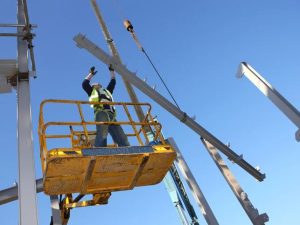What is a steel erector? A Steel Erection Specialist, commonly referred to as a "steel erector," plays a pivotal role in the construction industry, particularly in large-scale projects such as skyscrapers, bridges, and industrial facilities. These skilled professionals are responsible for assembling and installing structural steel components that form the skeletal framework of buildings or structures.

Job Description
1. Reading Blueprints : One of the primary responsibilities of a steel erector is interpreting complex blueprints and technical specifications. This involves understanding not only the physical dimensions but also the sequence of installation required to ensure structural integrity and safety.
2. Rigging and Lifting : Erectors use cranes and hoists to lift and position steel beams and other components into place. This requires precise coordination and knowledge of rigging techniques to safely handle heavy loads without causing damage to materials or posing risks to personnel on site.
3. Bolting and Welding : Once steel components are positioned, they must be secured. Erectors often perform initial bolting and may assist welders in permanently joining pieces together. Attention to detail is crucial here to ensure connections meet engineering standards.
4. Safety Compliance : Safety is paramount in this line of work. Steel erectors must adhere strictly to Occupational Safety and Health Administration (OSHA) guidelines, wearing protective gear and following protocols to prevent accidents related to falls, electrical hazards, and machinery operations.
5. Problem Solving : Construction sites can present unexpected challenges. Steel erectors need to be resourceful, able to troubleshoot issues with alignment, fit, or material defects on the spot while working under tight deadlines.
6. Teamwork and Communication : Effective communication skills are essential for coordinating activities with fellow workers, engineers, and project managers. Teamwork ensures that each phase of the erection process flows smoothly and efficiently.
7. Physical Demands : The job is physically demanding, requiring strength and stamina. Erectors frequently lift heavy objects, climb ladders and scaffolding, and work at heights.
8. Environmental Conditions : Work conditions vary widely depending on the location. Erectors might find themselves working outdoors in all weather conditions, from extreme heat to freezing cold, which adds another layer of challenge to their daily tasks.
Training and Qualifications
Steel erectors typically receive training through apprenticeship programs, which combine classroom instruction with hands-on experience. They learn about blueprint reading, safety regulations, rigging procedures, and the use of specialized equipment. Continuous education and certification updates are necessary to keep up with evolving industry standards and technologies.




